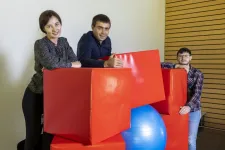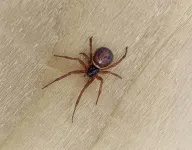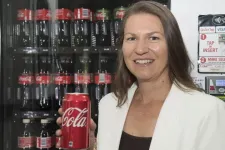Shiny mega-crystals that build themselves
The other side of entropy
2021-05-27
(Press-News.org) To really appreciate what a team of researchers led by Maksym Kovalenko and Maryna Bodnarchuk has achieved, it is best to start with something mundane: Crystals of table salt (also known as rock salt) are familiar to anyone who has ever had to spice up an overtly bland lunch. Sodium chloride - NaCl in chemical terms - is the name of the helpful chemical; it consists of positively charged sodium ions (Na+) and negatively charged chloride ions (Cl-). You can imagine the ions as beads that strongly attract each other forming densely packed and rigid crystals like the ones we can see in a saltshaker.
Many naturally occurring minerals consist of ions - positive metal ions and negative ions, which arrange themselves into different crystal structures depending on their relative sizes. In addition, there are structures such as diamond and silicon: These crystals consist of only one kind of atoms - carbon in the case of diamond -, but, similar to minerals, the atoms are also held together by strong bonding forces.
Novel building blocks for a new kind of matter
What if all these strong bonding forces between atoms could be eliminated? In the realm of atoms, with all the quantum mechanics at play, this would not yield a molecule or a solid-state matter, at least at ambient conditions. "But modern chemistry can produce alternative building blocks that can indeed have vastly different interactions than those between atoms," says Maksym Kovalenko, Empa researcher and professor of chemistry at ETH Zurich. "They can be as hard as billiard balls in a sense that they sense each other only when colliding. Or they can be softer on the surfaces, like tennis balls. Moreover, they can be built in many different shapes: not just spheres, but also cubes or other polyhedra, or more anisotropic entities."
Such building blocks are made of hundreds or thousands of atoms and are known as inorganic nanocrystals. Kovalenko's team of chemists at Empa and ETH is able to synthesize them in large quantities with a high degree of uniformity. Kovalenko and Bodnarchuk, and some of their colleagues the world over, have been working for about 20 years now with these kinds of building blocks. The scientists call them "Lego materials" because they form long-range ordered dense lattices known as superlattices.
It had long been speculated that mixing different kinds of nanocrystals would allow the engineering of completely new supramolecular structures. The electronic, optical or magnetic properties of such multicomponent assemblies would be expected to be a mélange of the properties of the individual components. In the early years, the work had focused on mixing spheres of different sizes, resulting in dozens of various superlattices with packing structures that mimic common crystal structures, such as table salt - albeit with crystal unit cells ten- to 100-times larger.
With their latest article in "Nature", the team led by Kovalenko and Bodnarchuk now managed to expand the knowledge a great deal further: They set out to study a mixture of different shapes - spheres and cubes to start with. This seemingly simple deviation from the mainstream immediately led to vastly different observations. Moreover, the chosen cubes, namely colloidal cesium lead halide perovskite nanocrystals, are known as some of the brightest light emitters developed to date, ever since their invention by the same team six years ago. The superlattices the researchers obtained are not only peculiar as far as their structure is concerned, but also with respect to some of their properties. In particular, they exhibit superfluorescence - that is, the light is irradiated in a collective manner and much faster than the same nanocrystals can accomplish in their conventional state, embedded in a liquid or a powder.
Entropy as an ordering force?
Upon mixing spheres and cubes, wondrous things happen: The nanocrystals arrange themselves to form structures familiar from the world of minerals such as perovskites or rock salt. All these structures, however, are 100-times larger than their counterparts in conventional crystals. What's more: A perovskite-like structure had never before been observed in the assembly of such non-interacting nanocrystals.
Especially curious: These highly ordered structures are created solely by the force of entropy - that is, the perpetual endeavor of nature to cause maximum disorder. What a perfect joke of nature! This paradoxical assembly occurs because, during crystal formation, the particles tend to use the space around them most efficiently in order to maximize their freedom of motion during the late stages of solvent evaporation, i.e. before they are "frozen" in their eventual crystal lattice positions. In this regard, the shape of the individual nanocrystals plays a crucial role - soft-perovskite cubes allow for a much denser packing than what is attainable in all-spherical mixtures. Thus, the force of entropy causes the nanocrystals to always arrange in the densest possible packing - as long as they are designed such that they do not attract or repel each other by other means, such as electrostatics.
The dawn of a new science
"We have seen that we can make new structures with high reliability," says Maksym Kovalenko. "And this now raises many more questions; we are still at the very beginning: What physical properties do such weakly bonded superlattices exhibit and what is the structure-property relationship? Can they be used for certain technical applications, say, in optical quantum computing or in quantum imaging? According to what mathematical laws do they form? Are they truly thermodynamically stable or only kinetically trapped?" Kovalenko is now searching for theorists who might be able to predict what may yet happen.
"We will eventually discover completely new classes of crystals," he speculates, "ones, for which there are no natural models. They will then have to be measured, classified and described." Having written the first chapter in the textbook for a new kind of chemistry, Kovalenko is more than ready to deliver his share to make that happen as fast as possible. "We are now experimenting with disk- and cylinder-shaped nanocrystallites. And we're very excited to see the new structures they enable", he smiles.
INFORMATION:
[Attachments] See images for this press release:

ELSE PRESS RELEASES FROM THIS DATE:
2021-05-27
Scientists at Nanyang Technological University, Singapore (NTU Singapore) have developed a new biomaterial made entirely from discarded bullfrog skin and fish scales that could help in bone repair.
The porous biomaterial, which contains the same compounds that are predominant in bones, acts as a scaffold for bone-forming cells to adhere to and multiply, leading to the formation of new bone.
Through laboratory experiments, the NTU Singapore team found that human bone-forming cells seeded onto the biomaterial scaffold successfully attached themselves and started multiplying - a sign of growth. They also found that the risk of the biomaterial triggering an inflammatory response is low.
Such a scaffold could be used to help with the regeneration of ...
2021-05-27
The parents of children with rare diseases face exceptional circumstances which influence their role as parents. Sometimes, the role of caregivers is added to that of parents. On other occasions, especially with the most serious cases, the former becomes more prominent than the latter. There are also cases in which both roles coexist separately, allowing them to be parents and caregivers in equal measure. However, whichever group they belong to, they need trust and to overcome fear in order to live their experience without overwhelming anxiety.
This is one of the findings of an open-access study published in the International Journal of Environmental ...
2021-05-27
NUI Galway study confirms that the Noble False Widow spider does have public health implications
Research team have established a DNA database to allow clinicians dealing with cases to confirm the species identity using genetic analysis
Epidemiology of bites reveals that almost all bites occurred in and around the home, and 88% of bites occurred when the victim was either asleep in bed or when the spider was trapped in clothing
In parts of Ireland and Britain, the False Widow spider has become one of the most common species of spiders found in and around urban habitats
A team of scientists from NUI Galway have published a new study showing that Noble False Widow spiders ...
2021-05-27
Eating habits amongst the young changed during the lockdown imposed due to COVID-19 and worsened in the case of those belonging to socioeconomically disadvantaged groups. These are the chief findings of an open access study published in specialist journal Nutrients, headed by researchers Alícia Aguilar Martínez, of the Universitat Oberta de Catalunya, and Marina Bosque Prous, of the UOC and UManresa, as part of the DESKcohort project of the interuniversity Epidemiology and Public Health research group GRESP.
The study, of 303 Catalan young people aged between 12 and 18, sought to establish how this age group's diet had changed from March to May 2020, in terms of both eating behaviours and the products consumed. The goal was to collect data to ascertain ...
2021-05-27
For years, food producers who make lightly preserved, ready-to-eat food have had to follow a set of guidelines to stop growth of Clostridium botulinum bacteria and production of a strong neurotoxin. The toxin can cause a serious illness called botulism.
For refrigerated products, the guidelines for controlling Clostridium botulinum indicate that the water contained in the products should have a salt content of at least 3.5%. Unfortunately, this hampers efforts to develop salt-reduced products, even though such products would benefit public health, as most consumers eat more salt than recommended.
If food producers want to launch products that contain e.g. less salt, they have had to conduct laboratory experiments to document ...
2021-05-27
Current neural network algorithms produce impressive results that help solve an incredible number of problems. However, the electronic devices used to run these algorithms still require too much processing power. These artificial intelligence (AI) systems simply cannot compete with an actual brain when it comes to processing sensory information or interactions with the environment in real time.
Neuromorphic chip detects high-frequency oscillations
Neuromorphic engineering is a promising new approach that bridges the gap between artificial and natural intelligence. An interdisciplinary research team at the University of Zurich, the ETH Zurich, and the ...
2021-05-27
What keeps consumers hooked on high sugar soft drink? Advertising, of course. But why are some consumers more adept at ignoring these cues than others?
A new study from Flinders University, published in Appetite, found participants with an automatic bias towards soft drinks - or difficulty resisting sweet drinks compared to non-sweetened control beverages (e.g., water) - were more responsive to the ads than those without these tendencies.
The Australian study compared the ability of 127 university-age students (18-25 year olds) to withstand or succumb to the urge to reach for a soft drink when viewing television advertisements.
"Perhaps, then, we can start targeting people who show these ...
2021-05-27
Analysis using a national medical database revealed that the cumulative incidence of autism spectrum disorders (ASD) in children born in 2009-2014 was 2.75% by the age of five. A research group led by Associate Professor Daimei Sasayama and Professor Hideo Honda of the Department of Child and Adolescent Development Psychiatry, Shinshu University School of Medicine, used a national medical database to analyze autism spectrum disorders in Japan. It was reported that the cumulative incidence showed an increasing trend for each year of birth, and that there were regional differences.
This cumulative incidence of ASD is the highest in the world based on medical diagnosis, suggesting high diagnostic ...
2021-05-27
Poor sleep impacts the risk of long-term cognitive decline in Hispanic/Latino middle aged and older adults differently than it does in non-Hispanic adults, according to research led by University of Miami Miller School of Medicine neurology faculty and the largest long-term study of U.S. Hispanic/Latinos to date.
During seven years of follow-up, Hispanics/Latinos were more likely to develop cognitive declines in processing speed, mental flexibility, and verbal memory, if they had sleep disordered breathing, such as obstructive sleep apnea, and long sleep duration of nine or more hours. The risk was especially high in middle-aged adults without metabolic syndrome and women without obesity or metabolic syndrome ...
2021-05-27
Oysters' exposure to plastics is concerning, particularly because these materials can accumulate and release metals which are then absorbed by the molluscs. According to a recent study published in the journal Chemosphere, the combined presence of nanoplastics and arsenic affects the biological functions of oysters. This study was conducted by the Institut national de la recherche scientifique (INRS) in Québec City and the French National Centre for Scientific Research (CNRS) at the University of Bordeaux in France.
The international research team chose to study arsenic, since it is one of the most common metals absorbed ...
LAST 30 PRESS RELEASES:
[Press-News.org] Shiny mega-crystals that build themselves
The other side of entropy


